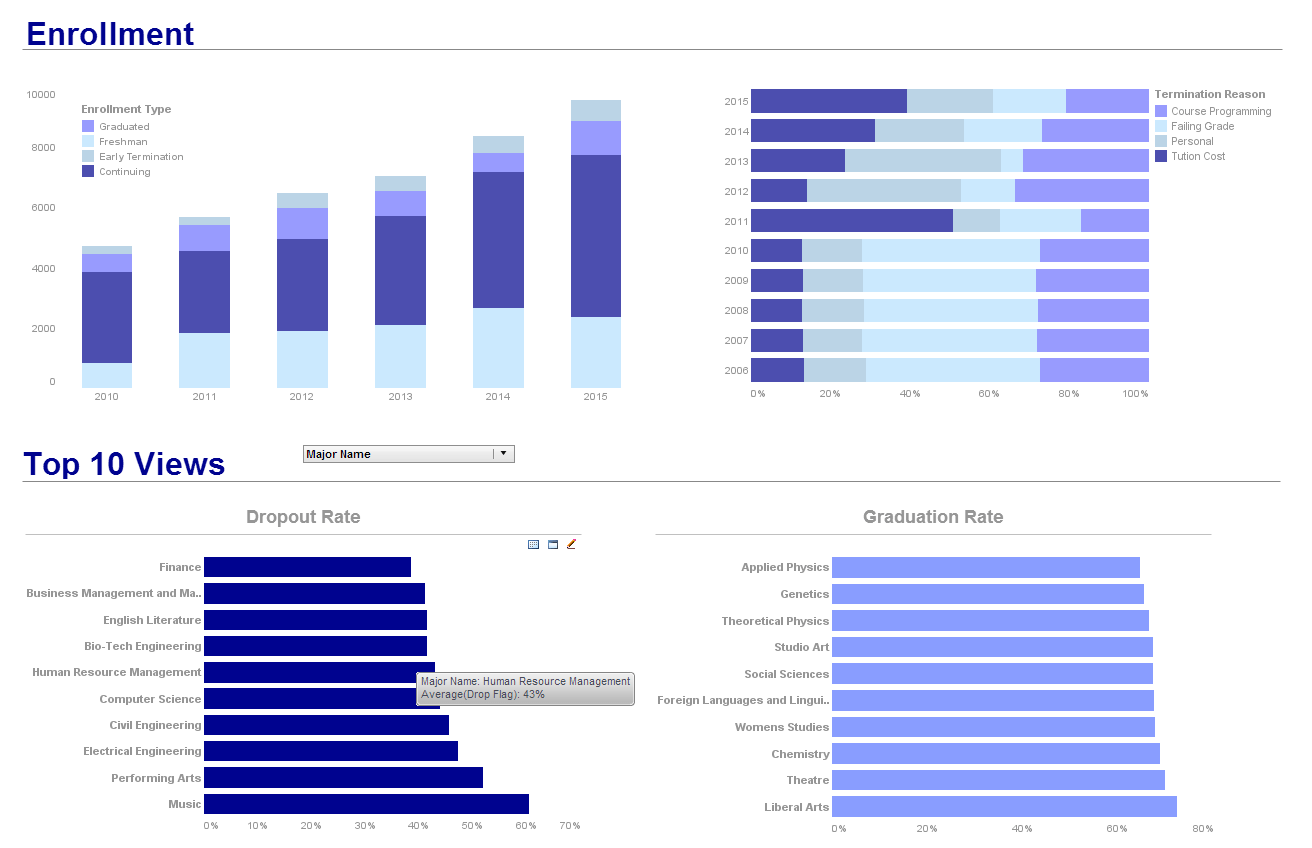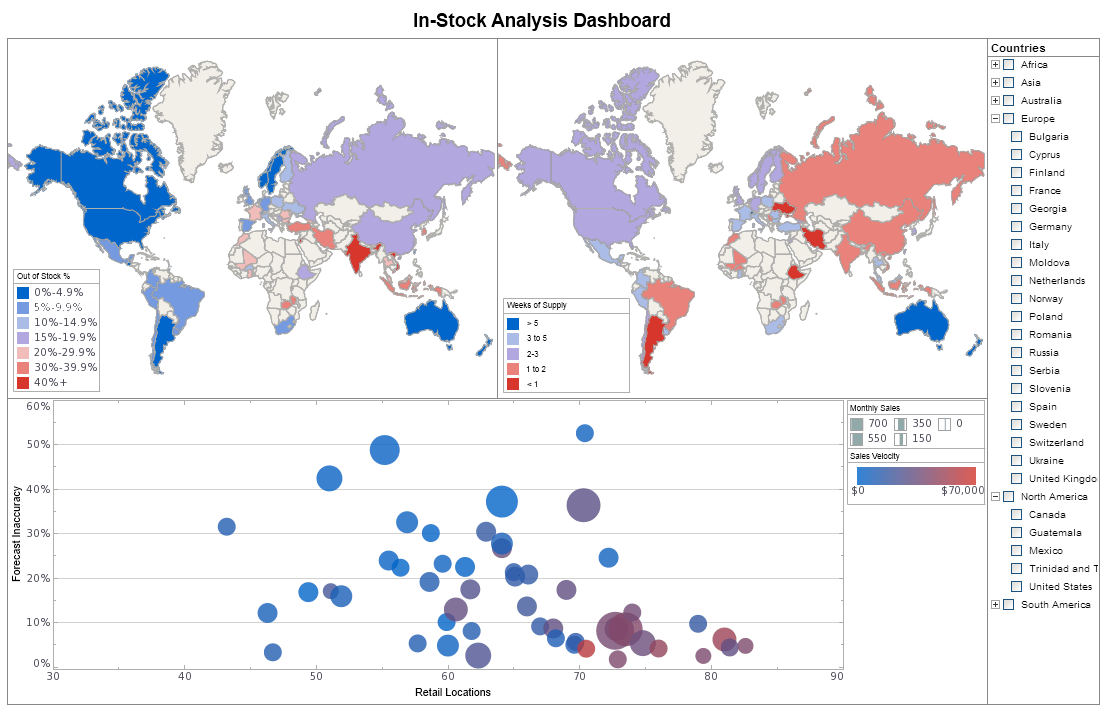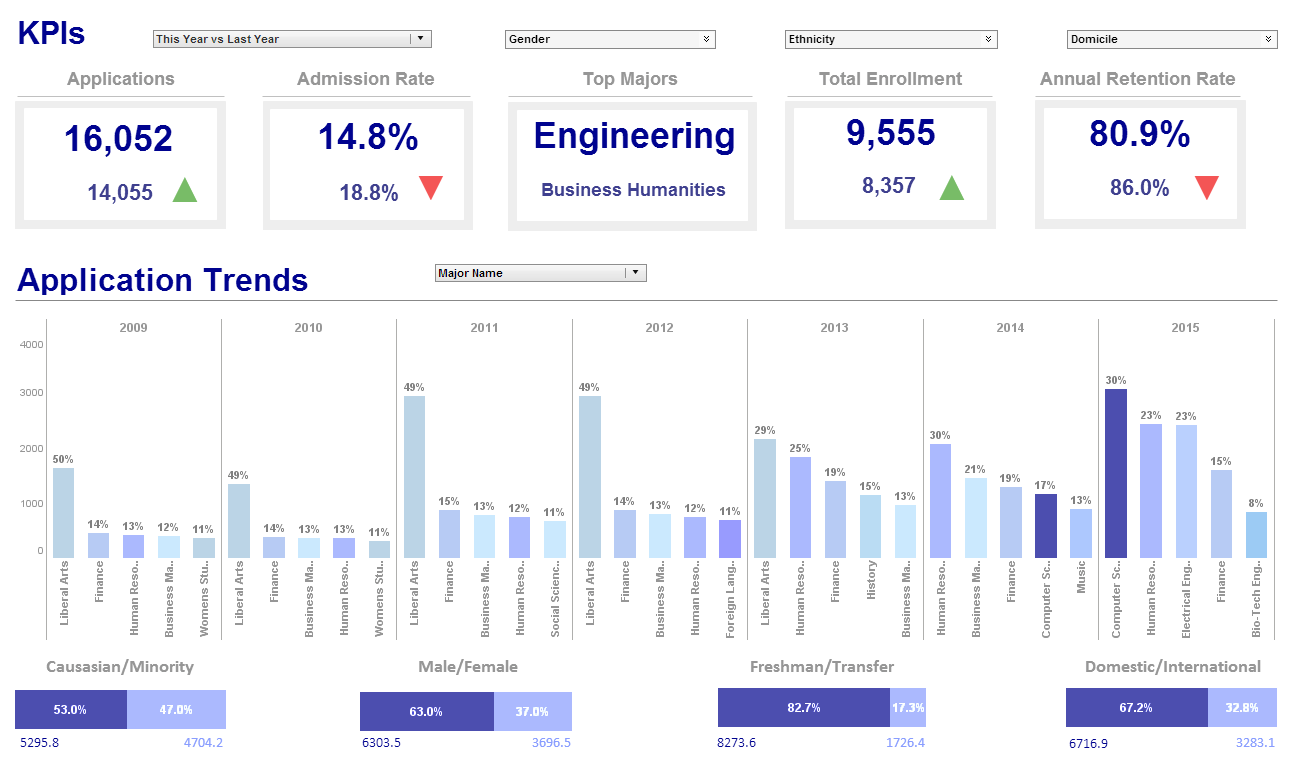Visual Analytics Company: InetSoft Technology
Are you looking for a good visual analytics company? Since 1996 InetSoft has been making business software that is easy to deploy and easy to use. Build self-service oriented dashboards and visual analyses quickly. View a 2-minute demo and download a free version.
Why InetSoft?
InetSoft's mobile BI reporting application is easy enough to be:
- Deployed in just weeks
- Learned by end users with minimal training
- Used by any executive without the aid of IT
agile enough to be:
- Adaptable to changing data and business needs
- Used for data exploration through visualization
- Capable of maximum self-service
and robust enough to:
- Attract the attention of executives
- Meet the demands of power users
- Scale up for organizations of any size
Evaluate StyleBI from InetSoft. It's Easy. Agile. & Robust.
Register for more info and to download free eval software
About InetSoft
Since 1996 InetSoft has been delivering easy, agile, and robust business intelligence software that makes it possible for organizations and solution providers of all sizes to deploy or embed full-featured business intelligence solutions. Application highlights include visually-compelling and interactive dashboards that ensure greater end-user adoption plus pixel-perfect report generation, scheduling, and bursting. InetSoft's patent pending Data Block technology enables productive reuse of queries and a unique capability for end-user defined data mashup.
This capability combined with efficient information access enabled by InetSoft's visual analysis technologies allows maximum self-service that benefits the average business user, the IT administrator, and the developer. InetSoft was rated #1 in Butler Analytics Business Analytics Yearbook, and InetSoft's BI solutions have been deployed at over 5,000 organizations worldwide, including 25% of Fortune 500 companies, spanning all types of industries.

How Do Analysts in Epigenetics Research and Therapy Companies Use Visual Analytics?
Analysts in epigenetics research and therapy companies utilize visual analytics to gain insights, make informed decisions, and drive advancements in their field. Visual analytics, a multidisciplinary field that combines data analysis with interactive visual interfaces, is particularly valuable in the complex and data-intensive realm of epigenetics. This branch of genetics focuses on the study of heritable changes in gene expression that do not involve alterations to the underlying DNA sequence. Given the complexity and vastness of epigenetic data, visual analytics provides an essential toolset for analysts to interpret and utilize this information effectively. Here's an in-depth look at how analysts use visual analytics in epigenetics research and therapy.
Understanding Epigenetic Data
Epigenetics research generates large volumes of data, including DNA methylation patterns, histone modification profiles, and chromatin accessibility data. These data types are multidimensional and require sophisticated methods to understand and interpret. Visual analytics helps analysts by providing interactive tools that can display these complex datasets in an intuitive and comprehensible manner.
For instance, heatmaps are commonly used to represent DNA methylation data, where the methylation levels across different genomic regions and samples are displayed using a color gradient. Analysts can quickly identify patterns, such as hypermethylated or hypomethylated regions, which may be associated with specific diseases or phenotypes. By using interactive heatmaps, analysts can zoom in on particular regions of interest, filter the data based on certain criteria, and compare different samples or conditions.
Identifying Patterns and Anomalies
One of the primary uses of visual analytics in epigenetics is to identify patterns and anomalies in the data. Analysts employ various visualization techniques such as scatter plots, line charts, and clustering diagrams to explore relationships and trends. For example, scatter plots can be used to examine the relationship between gene expression levels and methylation status across different samples. Clustering algorithms combined with visual interfaces can help group similar epigenetic profiles, revealing underlying patterns that may not be apparent through traditional statistical methods.
Visual analytics also aids in anomaly detection. Analysts can use box plots and histograms to identify outliers in the data, which could indicate potential errors or novel insights. These outliers might represent rare but significant epigenetic modifications that could be crucial for understanding disease mechanisms or therapeutic responses.
Integrating Multimodal Data
Epigenetics research often involves integrating multiple types of data, including genomic, transcriptomic, proteomic, and clinical data. Visual analytics platforms allow analysts to overlay these different data types onto a single interface, providing a holistic view of the biological processes at play. For example, a Circos plot can visualize relationships between different types of genomic data, such as DNA methylation and gene expression levels, on a circular layout. This integrated view enables analysts to observe how changes in one data type correlate with changes in another, facilitating a deeper understanding of the regulatory mechanisms involved.
Hypothesis Generation and Testing
Visual analytics tools support hypothesis generation and testing by allowing analysts to interact with the data in real time. Analysts can use visual interfaces to formulate hypotheses about the potential roles of specific epigenetic modifications in disease progression or therapeutic response. For example, by visualizing changes in methylation patterns before and after treatment, analysts can hypothesize about which epigenetic marks might be associated with therapeutic efficacy.
Once a hypothesis is generated, visual analytics can also assist in testing it. Analysts can use visual filters and interactive queries to subset the data based on specific criteria, such as selecting samples with particular epigenetic modifications or clinical outcomes. By visualizing the results of these queries, analysts can quickly assess whether the data supports their hypotheses, enabling more efficient and effective research workflows.
Enhancing Collaboration and Communication
Visual analytics tools are invaluable for enhancing collaboration and communication among researchers, clinicians, and other stakeholders in the epigenetics field. Interactive visualizations can be shared across teams, enabling researchers to collaboratively explore the data and discuss findings. For example, dashboards that display key metrics and visualizations can be used in team meetings to review progress and make data-driven decisions.
Moreover, visual analytics makes it easier to communicate complex findings to non-expert stakeholders, such as funding bodies or patient advocacy groups. Interactive visualizations can be used to create compelling narratives that explain the significance of the research and its potential impact on patient care. This can help secure funding, support regulatory submissions, and inform clinical decision-making.
Driving Personalized Medicine
Personalized medicine aims to tailor medical treatments to individual patients based on their unique genetic and epigenetic profiles. Visual analytics plays a crucial role in this endeavor by enabling analysts to integrate and interpret large-scale epigenetic data alongside clinical data. For instance, analysts can use visual analytics to identify epigenetic biomarkers that predict response to specific therapies. By visualizing the relationships between these biomarkers and clinical outcomes, analysts can help design personalized treatment plans that maximize efficacy and minimize adverse effects.
Additionally, visual analytics tools can be used to monitor patients over time, tracking changes in their epigenetic profiles and adjusting treatment plans accordingly. This dynamic approach to personalized medicine ensures that treatments remain effective as patients' conditions evolve.
Case Studies and Applications
Several case studies highlight the successful application of visual analytics in epigenetics research and therapy. For example, researchers studying cancer epigenetics have used visual analytics to identify key methylation changes associated with tumor progression and response to therapy. By visualizing these changes, they have been able to pinpoint potential therapeutic targets and develop more effective treatment strategies.
In another example, analysts studying neurodevelopmental disorders have used visual analytics to explore the epigenetic landscape of brain development. By integrating data from multiple sources, including DNA methylation, histone modifications, and gene expression, they have uncovered critical regulatory mechanisms that govern brain development and identified potential intervention points for therapeutic development.
More Articles About Visual Analytics
Building Comprehensive Analyses - StyleBI offers an interface for building comprehensive analyses in the form of interactive multidimensional charts, giving you direct access to insights that used to require several pages of reporting to put together. The application provides a wide array of filtering options, such as sliders, rulers, and selection lists, which you can use to modify visualizations and manipulate metrics in real time. SI also boasts the ability to access data from many disparate sources, effectively freeing the user from the constraint of needing a data warehouse...
Evolution of Tools for Java Reports - Over the years InetSoft has extended the very mature and feature-rich Java reporting engine that underpins Style Report into a business intelligence software platform that enables interactive visual analysis and dashboards, in addition to sophisticated and flexible reporting. It's called StyleBI...
Financial Advisory Consultant Dashboards - Digital dashboards have become indispensable tools for financial advisory consultants in today's fast-paced, data-driven business environment. They serve as dynamic interfaces that consolidate and visualize crucial information from various sources, allowing consultants to make informed decisions and offer valuable insights to their clients. Here's a comprehensive look at how financial advisory consultants use digital dashboards...
Invoice Aging Analysis - Examines the aging of outstanding invoices. Helps identify overdue accounts and devise strategies for timely collections. Trend Analysis Analyzes billing data over time to identify patterns and trends. Enables proactive decision-making and the anticipation of future challenges...





